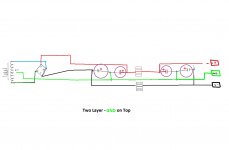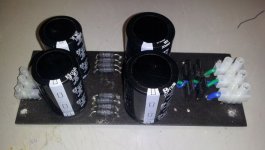can we use semisouth r100 here to replace irfp240 in the se output stage and using 1 x pair per side
If you want one pair of R100 per channel, that sounds like a perfect job for the F6. It was designed for exactily that.
And, it uses the R100 to best effect, not being a follower, you hear the intrinsic awesomeness of the power Jfet.
power supply
Hey,BCMBOB,
That looks good,lol was alot of fun too,lol.Most won't go to the trouble ,but it's fun to build ,
Have fun,
NS
The PS design for the BA-3 project was changed to what 6L6 posted. If interested, the fabrication process can be seen HERE
Hey,BCMBOB,
That looks good,lol was alot of fun too,lol.Most won't go to the trouble ,but it's fun to build ,
Have fun,
NS
For those interested in Keratherm I have just used it to mount mosfets onto the heatsinks. Came in sheet form, which was easy to cut with scissors and an old punch for putting holes in leather belts. Easier to work with when mounting the mosfets because no requirement for grease unlike the mica pieces I previously used. Can get Keratherm from Young Electrical Group here in the UK if anyone interested but mica is cheaper.
Chris
Chris
That's because it depends,
...on both PSU voltage and output devices.
If you look at the power output graphs on the various pages in the BA-3 article you can see where the distortion goes through the roof -- that point is the max power output: roughly 25WPC with 24V rails, and about 50WPC with 32V rails.
More output devices gets you more current, which will translate into more watts into lower impedance loads.
...on both PSU voltage and output devices.
If you look at the power output graphs on the various pages in the BA-3 article you can see where the distortion goes through the roof -- that point is the max power output: roughly 25WPC with 24V rails, and about 50WPC with 32V rails.
More output devices gets you more current, which will translate into more watts into lower impedance loads.
That's because it depends,
...on both PSU voltage and output devices. ................
More output devices gets you more current, which will translate into more watts into lower impedance loads.
I think most folks think of power in terms of something that could be called "native SPL" - (not an official term but descriptive). Are you saying more devices doesn't necessarily translate directly to higher apparent power when used with a "standard" 8 ohm speaker? I found that to be the case with a single LM3886 build compared to a three chip parallel build.
Power is I^2 x R. So, basically speaking, if your R=8 ohms, to increase power you need to increase current through the speaker.
Bias current in the amp dosent necessarily mean more current though the speaker. But it can be a limiting factor, just as the amps maximum output voltage can be. You need a good logical balance of the two.
There are other factors such as the speaker maintaining a mostly resistive load to the amp. It's not just the "dip" in impeadance shown on some impeadance graphs. When inductance, capacitance and phase angles come into the game, and it will, you start getting complex loading that can draw more current than just the "8 ohms" would suggest. Therefore it's a good idea to plan on having extra current available. The BA-3 with complementary output is probably good at that, albeit moving to Class AB operation, espeseally with a good PSU. The SE BA-1 type output design may be somewhat limited with difficult loads.
So, Back to more power. If you want to maintain ClassA operation as much as possible, and higher power, you would be wise to consider having enough current to at least drive your nominal load to within a few volts of your PSU rail voltage. That may require more output transistors. But, higher bias per device will do it also. The product of Iq x Vds of the output devices may be a limiting factor here. Something below 30W/device is a good safe reliable operating point or rule of thumb. It is a Burning Amp though
Bias current in the amp dosent necessarily mean more current though the speaker. But it can be a limiting factor, just as the amps maximum output voltage can be. You need a good logical balance of the two.
There are other factors such as the speaker maintaining a mostly resistive load to the amp. It's not just the "dip" in impeadance shown on some impeadance graphs. When inductance, capacitance and phase angles come into the game, and it will, you start getting complex loading that can draw more current than just the "8 ohms" would suggest. Therefore it's a good idea to plan on having extra current available. The BA-3 with complementary output is probably good at that, albeit moving to Class AB operation, espeseally with a good PSU. The SE BA-1 type output design may be somewhat limited with difficult loads.
So, Back to more power. If you want to maintain ClassA operation as much as possible, and higher power, you would be wise to consider having enough current to at least drive your nominal load to within a few volts of your PSU rail voltage. That may require more output transistors. But, higher bias per device will do it also. The product of Iq x Vds of the output devices may be a limiting factor here. Something below 30W/device is a good safe reliable operating point or rule of thumb. It is a Burning Amp though
Bob, It sounds like your "standard 8 ohm speaker" may have some low impedance dips and/or the impedance phase angle gets high. I found that LM3886 seems to be on the verge of triggering its internal protection circuits fairly easily when asked to deliver a lot of current. Not in a blatant way, just sounded a bit thin. Maybe that's the lower "apparent power" you noticed with your single.
@fig - nice info. At some point I hope to configure an entire system from the logical approach you detail. So far I've been building components (amps, dacs and speakers) fairly independently - mostly listening for differences within each group. The capacity matching phase is still in my future. I have often heard the best approach to system design is from the speakers backward - toward the power amp and pre and source.
I've built a bunch of amps (8 different flavors) over the past couple years. Unfortunately, that has distracted from completing the component upgrade (bought the parts months ago) on the Sunflower crossovers. When that project is completed I'll be looking forward to some tests and diagnosis to dial in the composite sound.
@ Bob E, a little better description of my comment - when I built a BPA 300 I naively expected three times the SPL as produced by a single chip MyRef - at the same volume pot setting. What I found was a little louder and maybe fuller, but no where near three times more powerful. As said in the last two posts, I learned I might have perceived greater differences had I been using lower impedance speakers.
The triggering of the LM3886 internal protection was as you say, a negative element in many of the early designs around that chip. I came in at V1.2 of the MR and since then Dario Inserra and Sivasnkar Chander (among others) have developed systems that have that problem essentially under control. In fact, when I trim down my amp collection the MR Fremen Edition and one Pass style build are what I will keep. Still need to investigate the complementary BA design. The new Aleph J boards are very tempting - but I'm trying my best to resist.


I've built a bunch of amps (8 different flavors) over the past couple years. Unfortunately, that has distracted from completing the component upgrade (bought the parts months ago) on the Sunflower crossovers. When that project is completed I'll be looking forward to some tests and diagnosis to dial in the composite sound.
@ Bob E, a little better description of my comment - when I built a BPA 300 I naively expected three times the SPL as produced by a single chip MyRef - at the same volume pot setting. What I found was a little louder and maybe fuller, but no where near three times more powerful. As said in the last two posts, I learned I might have perceived greater differences had I been using lower impedance speakers.
The triggering of the LM3886 internal protection was as you say, a negative element in many of the early designs around that chip. I came in at V1.2 of the MR and since then Dario Inserra and Sivasnkar Chander (among others) have developed systems that have that problem essentially under control. In fact, when I trim down my amp collection the MR Fremen Edition and one Pass style build are what I will keep. Still need to investigate the complementary BA design. The new Aleph J boards are very tempting - but I'm trying my best to resist.

I naively expected three times the SPL as produced by a single chip MyRef - at the same volume pot setting. What I found was a little louder and maybe fuller, but no where near three times more powerful.
The human ear is logarithmic to SPL, to get something twice as loud as a 25W Papa amp, you would need a 250W Papa amp, and to get something three times as loud, you would need 1250W.
But thats not the whole story, I have heard an Eddison 12 (an EL84 12W pentode) through IMF TSL 80 II speakers that sounded louder than a 50W bipolar amp through the same speakers! although it didn't measure that way; but there again, subjectivism is a controversial subject.
Yes, me too. I've mentioned it on other threads - but back in the 60's a Detroit store had the combination of some massive Bozak speakers that "they said" were being driven by a 3 watt tube amp. They could just about drive you out of the showroom.
It would be a real kick to put some of the modern stuff in a time machine, head back forty or so years and compare.
It would be a real kick to put some of the modern stuff in a time machine, head back forty or so years and compare.
- Home
- Amplifiers
- Pass Labs
- Burning Amp BA-3



 I have a set of Peter Daniel's Aleph J boards awaiting my attention, but ordered the store boards last night to go with my Jack of all Chassis. Hoping I can get a few decent matches out of my 20 SJ74s
I have a set of Peter Daniel's Aleph J boards awaiting my attention, but ordered the store boards last night to go with my Jack of all Chassis. Hoping I can get a few decent matches out of my 20 SJ74s